Free Template: How to Do a Fence Estimate
Simplify your fence estimation process, access our expert advice and try our downloadable fence estimate template, exclusively on Houzz Pro.

As a fence constractor, knowing how much it will cost you to complete a fence project is crucial for determining the total you will charge a client to cover your expenses and earn a profit in your fencing contractor business. In this article we cover all the bases of what it takes to draft a professional, precise fence estimate and deliver it to potential clients as quickly as they expect. Included in this article is a step by step guide of how to do a fence estimate and a free, downloadable, editable fencing estimate template.
We’ve broken the article down by various topics. Click on a link below to jump to the section you’re most interested in:
- Download our free fence estimate template
- What is a fence estimate?
- Why are fence estimates important?
- When do you send a fence estimate?
- What to include in a fence estimate template
- Optional sections to include in a fence estimate template
- How to create a fence estimate step-by-step
- Alternatives to fence estimate templates
- Final fence estimating tips
Download our Free Fence Estimate Template

Here's a Fence Estimate Template on Us!
Customize this Fence Estimate Template to secure your next job.
Juggling all the aspects of starting, and running, a fence contractor business takes stamina, skills and versatility. Delivering accurate estimates to set expectations for clients is a crucial piece for ensuring success in the fence construction industry. To help you hone your estimating skills, we offer a free fence estimate template to get you started. The template is available for both Word and Excel documents, and includes a sample fence estimate so you can see how other professionals in the industry do it.
The fence estimate template is downloadable so it can be printed, emailed and easily shared with clients and other team members. And, because the free fence estimate template is fully editable, you can tailor it to your specific needs, business and brand.
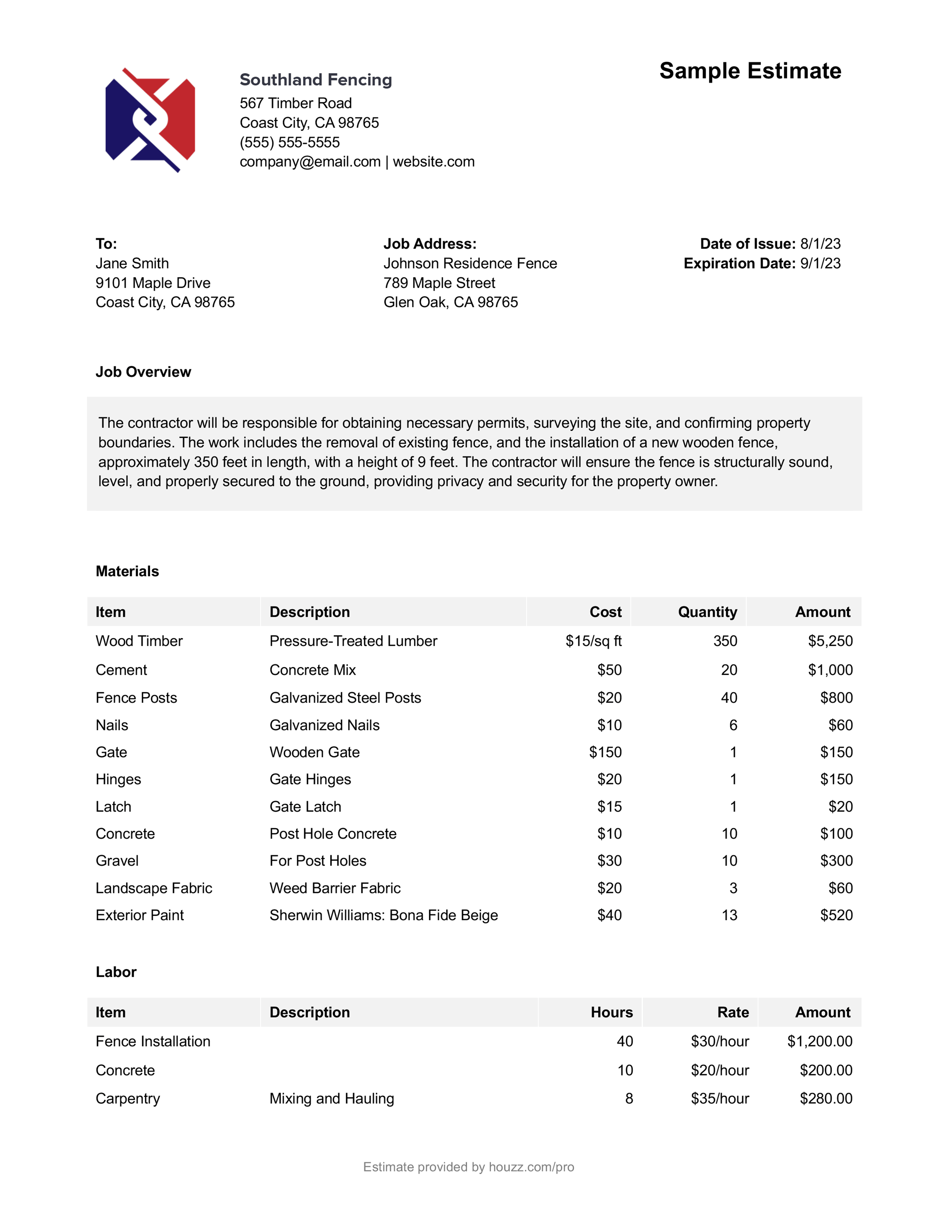
As you become more proficient in drafting fence estimate sheets, consider trying fence estimating software to create fence cost estimates more quickly and run your business more efficiently over the long run.
Fencing estimating software like Houzz Pro includes a built-in takeoff tool for easy measurements and calculations, and its all-in-one management software provides tools to manage every aspect of your business, and every project from start to finish. Explore our other fence cost estimate templates for free and try a free trial of Houzz Pro.

What is a Fence Estimate?
A fencing contractor provides potential clients with a fence cost estimate to set expectations for clients around how much a fencing project will cost them. It is an approximation of the total cost of labor, materials and other expenses that will be needed to supply and install a fence.
Typically, an estimate is not the final total, and is followed up with a more exact quote, which is the more specific amount of what a fence contractor will charge for the job. Some clients or jobs may require that you submit a bid as part of a bidding process involving multiple contractors. These are more detailed than an estimate. Bids also differ from a proposal which combines the information in estimates, bids and quotes, but also includes more details about the company and its past projects.

Why are Fence Estimates Important?
Fence estimates are not only beneficial to your potential clients in helping them decide if their project vision matches their budget, but it is helpful to you and the success of your business. An estimate gives you a clear idea of how much it will cost you to carry out a project and the total amount you will need to charge in order to earn a profit margin that keeps your business growing.
Several factors impact the cost of a fence project. Here are a few common ones to consider:
- Size of Property The materials and labor it will take to install or build a fence increases proportionally with the size of the perimeter being enclosed. Accurate measurements of the area are of course essential to determining those costs.
- Property Grade Not all fencing projects are created equal. More difficult terrain will not only make bringing in equipment more challenging, but can add to the length of time it takes to complete the project. Consider, for example, how much leveling of the land may be needed before installing the new fence.
- Fence Function The purpose of the fence also influences the cost and type of fence being sought. Is it for privacy, aesthetics or protection? Does it need to be designed so that pets and other animals cannot penetrate it? Is it intended to protect children from accessing a backyard swimming pool or pond? Costs of materials and labor will vary depending on whether it is a rail fence, picket fence or privacy fence.
- Fence Height The amount of materials needed also varies depending on the height of a fence. While decorative, front yard fences are often lower in height, those being constructed for privacy or protection can be significantly higher. Heights, too, are typically subject to local regulations.
- Fence Style The style of fence being sought also impacts the costs. A basic chain link fence will be significantly less expensive than a customized wrought iron fence, for example.
- Condition of Fence If you are being hired to repair an existing fence, consider the extent of the work and the condition of the existing structure.
Materials The desired purpose of the fence can also impact the materials, and the type of materials impact the bottom line. Here are some popular fence materials. Research the prices for each of these commonly used materials in your region to help calculate the costs:
- Wood
- Wrought Iron
- Vinyl
- Aluminum
- Galvanized Steel
- Metal
- Composite
- Chain link
- Picket
- Electric
- Ranch

When do you Send a Fence Estimate?
A fence estimate template provides an approximation of the cost of a fence construction project, and therefore is often the first document you will provide a potential customer. Once the estimate is approved, you can then use the information to draft a more complete quote of exactly what you will charge for the project. This should be signed off on by all parties before the fence work begins.

What Should be Included in a Fence Estimate Template?
Here are some common items that fence contractors include in their fence estimate templates:
- Company Information Brand your estimate with your fence company information and logo to make it uniquely yours. Include the name and contact information of the person who will be the main contact person to make it easy for clients to reach out and have their questions answered.
- Client Information Include the name of the client, name of project and the person who will be the main contact point as the fence project progresses.
- Estimate Number & Date This information helps you keep your estimates organized and makes them easier to find as the volume of your projects increase over time. Create an intuitive numbering system to simplify locating documents.
- Table of Labor & Materials Detail the estimated labor and materials that will be needed to complete the project to make it easy for clients to understand the costs behind the fence project. This may include line items for materials such as fence posts, hardware, decorative post caps and concrete for setting posts.
- Summary of Costs This is a tally of all the costs involved in the fence installation project, and any other major line items.
- Acceptance & Signature Include a section for all parties to sign, date and accept the fence cost estimate template.

Optional Sections to Include in a Fence Estimate Template
Besides covering the basics, you may want to add additional sections to your fence cost estimate template, especially in cases where you think the extra information will increase your chances of winning the job. Here are some optional sections to consider depending on the circumstances and your approach:
- Scope of Work This details what work is included in the project and which items are not. It shows the homeowner that you understand the extent of the fence project they are seeking for their property and covers you if questions arise later. This provides clarity on the fence work included in the estimate, and those which would be add-ons to the estimate or omitted.
- Discounts Consider whether you want to offer reduced rates for first-time customers or clients that pay for the project up front, for example.
- Terms & Conditions This section could cover your policy on change orders or how much time a client has to inspect and sign off on a completed fence project. Some pros include an expiration date for the fence cost estimate since prices change over time. This can also double as a deadline for clients to make a decision.
- Disclaimer This can clarify that an estimate is not a formal contract for the fence project and will be followed with a more detailed quote.
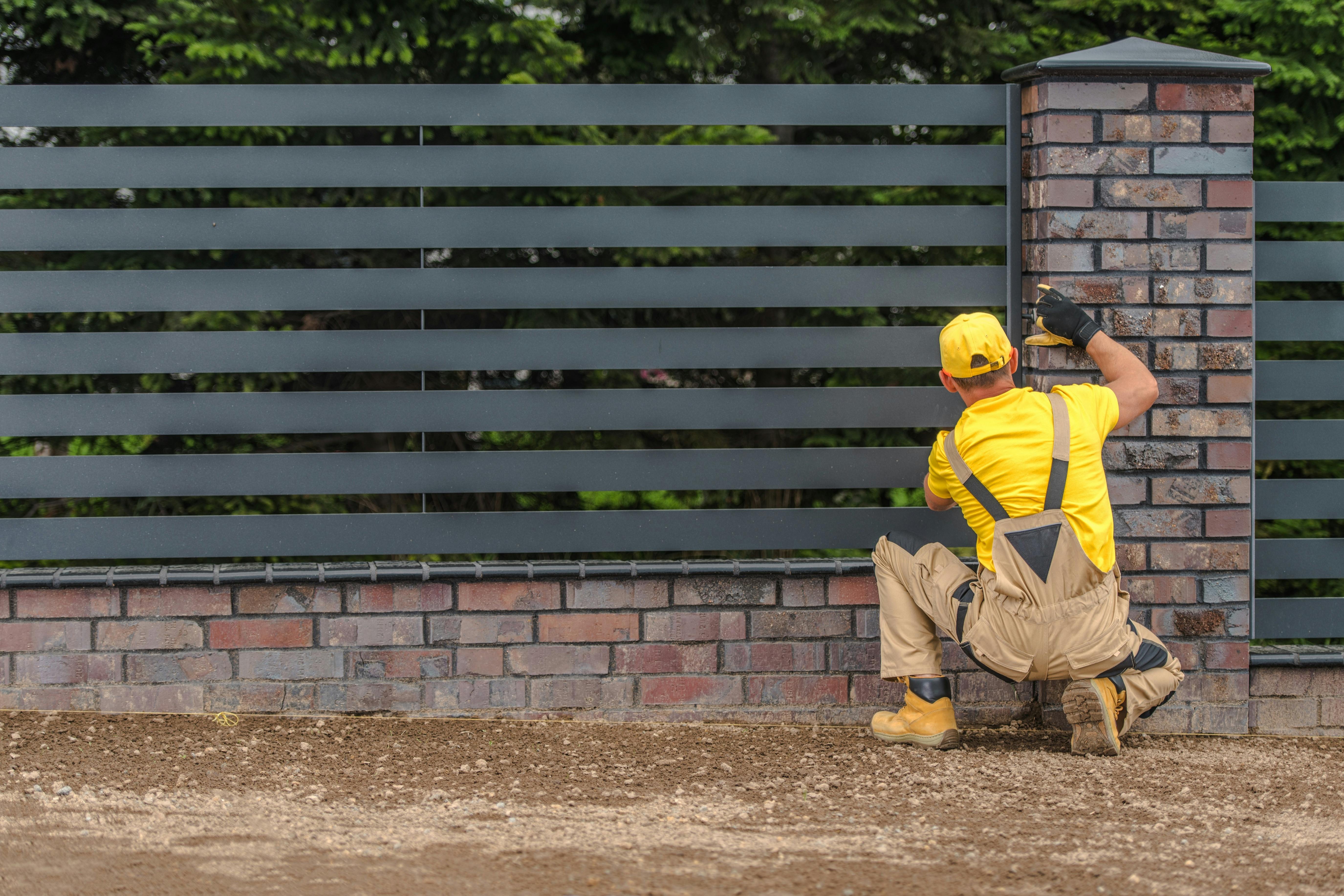
How to Create a Fence Estimate Step-by-Step
Now that you know what to include in a fence estimate, let’s explore the steps of how to do a fence estimate. Here are the areas to explore as you draft the fence estimate template and then deliver it to your potential client:
1. Permit Requirements Fences typically require a building permit, and the style, height and other considerations are usually governed by local regulations. Knowing the rules in the community will help you incorporate the costs of permits, advise clients on what types of fences are allowed, and head off issues down the road.
2. Choose an Estimate Template or Tool No one likes to stare at a blank document on a screen. Choose a free fence estimate template to develop your estimating muscle. A downloadable fence estimate template serves as a guide of what to include in the estimate. Make sure you pick an editable fence estimate template that you can easily customize to meet the specific needs of the project and your business. Fence estimating software can also greatly reduce the time it takes to create accurate and professional-looking estimates.
3. Review Project Plans Do you have all the measurements you need as well as a full understanding of the fence project you are being asked to execute? Review the plans, and if needed, visit the property and consult with the homeowner again to assure that you know the scope of the project being sought.
4. Estimate Material & Labor Costs
With an understanding of the extent of the work before you, begin calculating the costs of the fencing project. Here are the costs that will shape your total fence estimate:
- Variable Costs These change with every fence project, and with the market. They include your labor and material expenses.
- Fixed Costs Every fence estimate should figure in what it costs you monthly or annually to run your business. These prorated costs include expenses related to vehicles, rent, computers, utilities, accounting and more.
- Profit Determine the percentage profit you expect from every project that you can reinvest to grow your business. Your margin is your net sales revenues minus your labor, materials and overhead costs.
How to Estimate Fence Construction Labor The cost of labor varies with region, the scope of the fencing project and its complexity. Consider the level of skills required for the fence project and the time it will take to complete to calculate your hourly labor rate.
How to Estimate Fence Construction Materials Knowing the wholesale cost in your area of various fence materials such as wood, galvanized steel and vinyl will help you determine the prices per foot. Remember to add in other materials such as concrete, gate hardware and paint or stain.
- Locate Property Lines Because fences are often used to delineate lots, double check the location of the property lines to avoid costly misunderstandings going forward. If there is any uncertainty, make sure you have proper documentation from the local authorities or within the deed of the property.
- Locate any Barriers Walk the property and note anything that could impede the construction of a new fence such as trees, rocks, stumps, roots, sheds and underground utilities.
- Measure perimeter Accurate measurements determine how much material you will need and assure that you and your client are on the same page. Mark the perimeter and measure it.
- Prep/Post Work Note who will be responsible for preparing the site and any other prep or post work. Figure in those costs as needed.
5. Determine Markup Your markup costs should include your prorated overhead costs and profit margin. Factor these in to assure you are earning money from every project.
6. Calculate Total Costs Tally your total costs and your fence estimate is complete.
7. Seek A Second Opinion Ask a team member or a trusted peer to review your fence estimate to assure you have not overlooked anything.
8. Review & Send Look over your estimate one final time and hit send!
9. Track Changes & Approval Make sure you have an efficient process to track feedback from clients and the ultimate approval of the estimate.
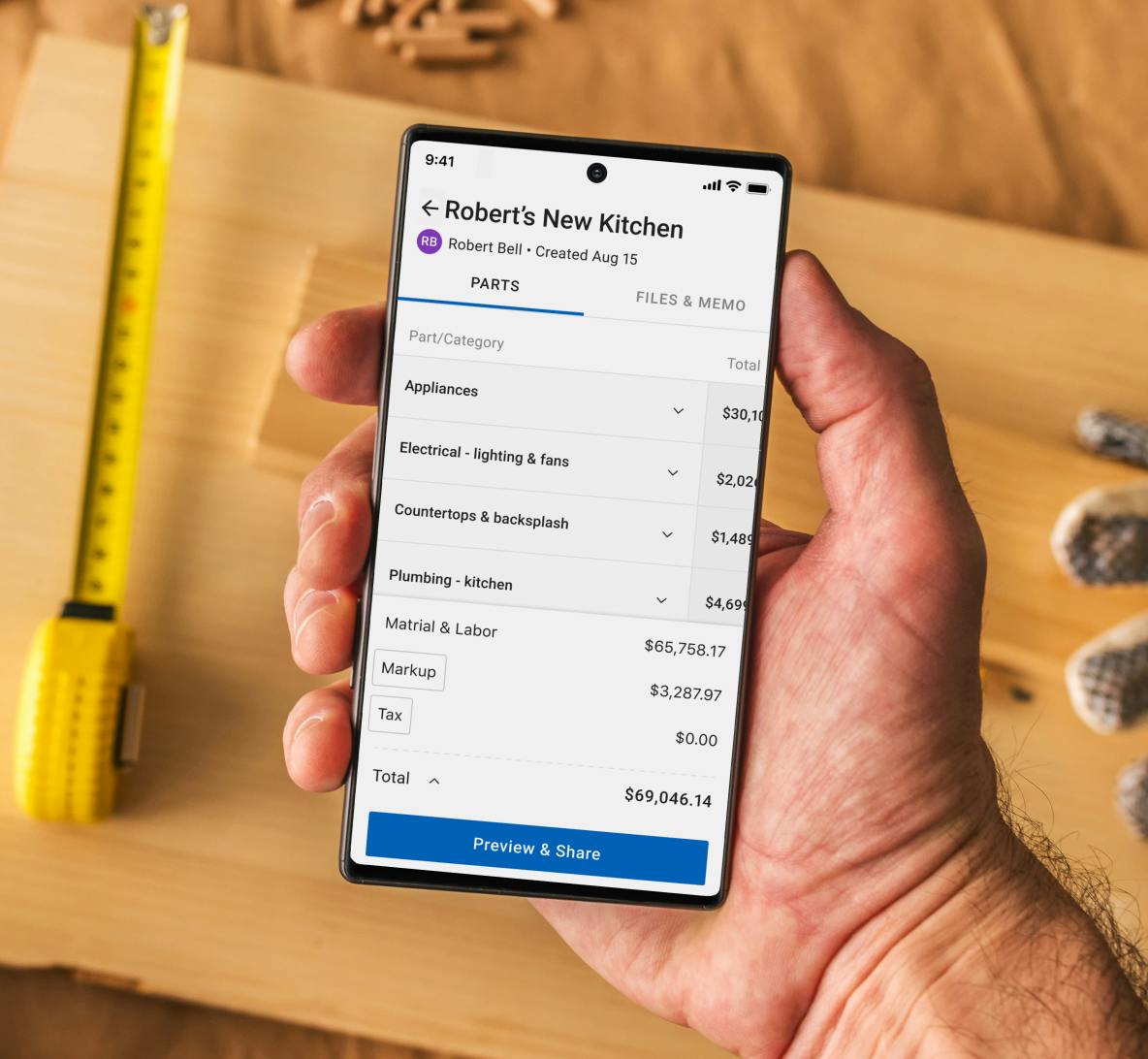
Alternatives to Free Fence Estimate Templates
While fence estimate templates provide a good launching pad for those learning estimation skills, many professionals turn to fence estimate software to create their estimates more quickly and run their businesses more efficiently. Measurements and calculations are easier with the takeoff tool that is built into the estimating software of Houzz Pro, for example. Contractors using Houzz Pro fence estimating software deliver their estimates to clients 10 times faster, and can easily customize their estimates with their business logo and branding.

Final Fence Estimating Tips
- Understand the Scope Making sure you know the full extent of the fence work before you dig the first post hole will help the project run more smoothly and avoid unpleasant budget surprises.
- Consider the Skills Required Both the type of fence and the complexity of the terrain helps determine the skill level required to build it. Installing an off the shelf straightforward fence on a flat yard, for example, takes less time and expertise than doing a custom build, incorporating artistic elements or installing along sloped landscapes. Consider the cost increases for acquiring more skilled labor and the availability of such trades people.
- Factor in Project Risks Account for what could go wrong, and consider whether a project presents more potential risks than usual.
- Don't Overlook Overhead It costs money to run a business so make sure you put a value on those expenses to help assure that your company will thrive for years to come.
- Include Groundwork, Other Services Calculate the related costs that go beyond assembling and installing the fence. These can add significantly to the cost of a project. Expenses to consider include acquiring required permits, researching property lines, site leveling, removal and disposal of the old fence; tree, stump and root removal; painting or staining of the new fence and more.
- Measure Up Against Competitors How do your fence estimates stack up with the amount other fence contractors in the area are charging for similar projects? Comparing your prices to that of your competitors can help you gauge whether you are charging within the range of what clientele in your market expect.
- Grow from Your Mistakes Making adjustments to your approach and pricing as you learn more and hone your estimation skills is all part of the process.
Conclusion
Winning fence projects starts with presenting clients with a fast, professional and accurate estimate of how much they can expect to pay to make the vision for their property come true. Knowing what to include in a fence estimate, planning for the unexpected and employing the right estimation tools helps professionals create estimates that go above and beyond the industry standard.
Fence contractor software such as Houzz Pro ups your estimation game even more. It lets fence contractors input their own price database or use the one provided in the software that is customized for their region and market. The software also includes a built-in takeoff tool so measurements and calculations are simplified and paper-free.
Explore our takeoffs and estimating features in the Houzz Pro fence contractor software especially designed for professionals in the fence industry. Try a free trial of Houzz Pro today.

Want advice delivered to your inbox?
Unlock industry insights and updates for contractors and design pros
By signing up, I agree to the Houzz Terms of Use and Privacy Policy and that Houzz may use my information to contact me about relevant content, products, and services.


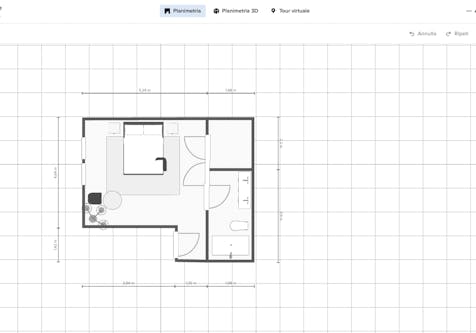




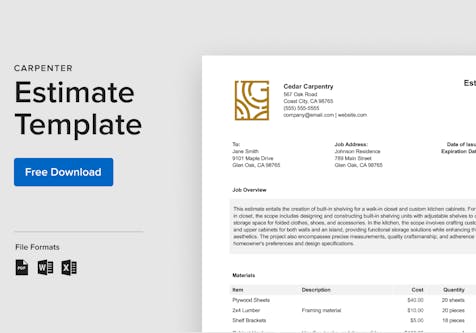

Join the conversation by commenting or asking a question below. The Houzz team reads every single comment, and we’ll get back to you by email if you need us!